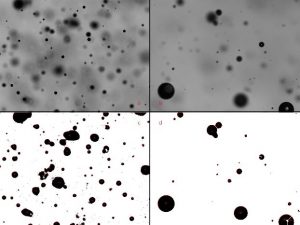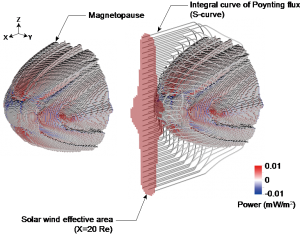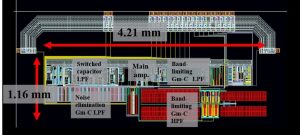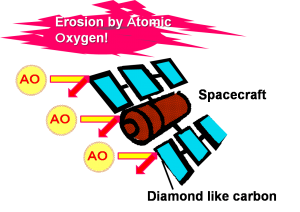2018 Activity Report for Mission 3: Sustainable Space Environments for Humankind
Updated: 2019/05/09
Award
The award of Tanakadate
【Winner】 Seiji Zenitani
【Awarding Organization】 Society of Geomagnetism and Earth, Planetary and Space Sciences
【Date】May 23, 2018
Research 1: Simulation study on substorms
Principal Investigator (PI): Yusuke Ebihara (RISH, Kyoto University)
Research collaborator(s): Takashi Tanaka (Kyushu University), Naoki Kamiyoshikawa (RISH, Kyoto University)
When an auroral breakup occurs, a large amount of energy (>1011 W) is consumed in the upper atmosphere in the polar region. The auroral breakup is regarded as a transient phenomenon, so that the magnitude of the auroral breakup is thought to be difficult. Using large-scale computer simulation with various solar wind parameters, we found that the maximum magnitude of the substorm (in terms of auroral electrojet) is roughly proportional to the incident energy through the magnetopause. About 33-88% of the incident energy originates from the solar wind kinetic energy. Energy flow and conversion from the solar wind to the Earth are clearly identified.
Publication
- Ebihara, Y., T. Tanaka, and N. Kamiyoshikawa, New diagnosis for energy flow from solar wind to ionosphere during substorm: Global MHD simulation, J. Geophys. Res. Space Phys., 124, 360-378, doi:10.1029/2018JA026177, 2019.
Research 2: Study on dynamic variation of relativistic electron fluxes in the radiation belts
Principal Investigator (PI): Yoshiharu Omura (RISH, Kyoto University)
Research collaborator: Yikai Hsieh (RISH, Kyoto University)
We have found that relativistic electrons in the Earth’s radiation belts are generated through nonlinear interaction with whistler-mode chorus emissions and that these electrons are precipitated by EMIC-triggered emissions. Nonlinear wave processes are essential, and they are clarified by test particle simulations. Using results of test particle simulations of electrons interacting with whistler mode chorus emissions, we numerically obtain Green’s functions to model evolution of the electron distribution function after all of the possible interactions with the waves. In both wave models with and without subpackets, electrons undergoing the cyclotron resonance with the waves are efficiently accelerated by nonlinear wave trapping. Since the strong modulation of the wave amplitude (in the case of the waves with subpackets) affects dynamics of resonant electrons, the electrons are detrapped from the wave potential or entrapped into it more frequently than those interacting with the waves without subpackets. As a result of interaction with the waves with subpackets, the number of electrons undergoing the acceleration is increased, while the acceleration efficiency in energy is decreased because of the shorter interaction time. Modifying the numerical Green’s function method with the simplified model of chorus waves uniform in longitude (Omura et al., 2015, https://doi.org/10.1002/2015JA021563), we compute the formation process of the outer radiation belt electron fluxes induced by the interaction with the chorus waves localized in longitude occurring for a time scale of 1 hr. The formation of MeV electron fluxes is characterized by large acceleration rates and butterfly pitch angle distributions, which are found in satellite observation results.

Formation of radiation belt due to electron acceleration by chorus emissions localized in longitudes
Publications, etc.
- Y. Kubota, and Y. Omura, Nonlinear dynamics of radiation belt electrons interacting with chorus emissions localized in longitude, Journal of Geophysical Research: Space Physics, 123, 4835–4857. https://doi.org/10.1029/2017JA025050, 2018.
- Y -K. Hsieh, and Y. Omura, Nonlinear damping of oblique whistler mode waves via Landau resonance. Journal of Geophysical Research: Space Physics, 123, 7462–7472, https://doi.org/10.1029/2018JA025848, 2018.
- L. Li, X.-Z. Zhou, Y. Omura, Z.-H. Wang, Q.-G. Zong, Y. Liu, et al., Nonlinear drift resonance between charged particles and ultralow frequency waves: Theory and observations. Geophysical Research Letters, 45, https://doi.org/10.1029/2018GL079038, 2018.
- B. Kakad, Y. Omura, A. Kakad, A. Upadhyay, and A. K. Sinha, Characteristics of subpacket structures in ground EMIC wave observations. Journal of Geophysical Research: Space Physics, 123. https://doi.org/10.1029/2018JA025473, 2018.
Research 3: Development of miniaturized plasma wave instruments for monitoring space electromagnetic environments
Principal Investigator (PI): Hirotsugu Kojima (RISH, Kyoto University)
Research collaborators: Takahiro Zushi (Affiliation:National Institute of Technology, Nara College), Yoshiya Kasahara (Graduate School of Natural Science and Technology, Kanazawa University)
The miniaturization of plasma wave instruments on board satellites and sounding rockets is essential, because required resource to onboard instruments is getting stringent these days. In particular, the use of micro/nano-satellites demands further reduction of their resources. Plasma wave instruments have a crucial role in exploring space environments. Since plasma wave instruments consume a lot of resources, they are not installed on micro/nano-satellites without some technical breakthrough. The present study has been aiming at this breakthrough by developing an IC chip which is designated to plasma wave instruments. In FY2018, we succeeded in achieving a new spectrum receiver that composes of the analogue chip and the digital FPGA. The developed spectrum receiver show the superior performance comparing with conventional spectrum receivers. The size of the developed receiver is 55 mm x 80 mm x 35 mm. The achievement of the small receiver with this size is a breakthrough in the miniaturization of plasma wave receivers. The receiver has the potential to provide waveforms and spectra by the same system, simultaneously and it shows the outlook of miniaturized plasma wave receivers in the future missions.
Publication
- Zushi, T., H. Kojima, Y. Kasahara, and T. Hamano, Development of a miniaturized spectrum-type plasma wave receiver comprising an application-specific integrated circuit analog front end and a field-programmable gate array, Meas. Sci. Technol., 30,doi: 10.1088/1361-6501/ab0821, 2019.
Research 4: Application research into new materials for space missions
Principal Investigator (PI): Yoshikatsu Ueda (RISH, Kyoto University)
Research collaborator(s): Yomei Tokuda, Liao Zhenghao (Tongji University, China), Vishnu Thonglek, Rattanaporn Norarat(Rajamangala University of Technology Lanna, Thailand)
We conduct basic and application research on fine bubble technology as a new material expected for future space mission. We also have been collaborating with internal/international university as interdisciplinary mission theme.

High-speed image of microbubble generation with/without UFB (a: original photo of ejected water with UFB; b: original photo of ejected water without UFB; c: photo a after analyze particles; d: photo b after analyze particles)
Pubulication
- V. Thonglek, K. Yoshikawa, Y. Tokuda and Y. Ueda, Identification of High Concentration Ultra-Fine Bubbles in the Water, International Journal of Plasma Environmental Science and Technology, 2018/12
Research 5: Microstructural analysis of wood-based, diamond-like carbon for improved resistance against atomic oxygen
Principal Investigator (PI): Toshimitsu Hata (RISH, Kyoto University)
Research collaborator(s): Hirotugu Kojima, Yuki Tobimatsu (RISH, Kyoto University)
Critical and rapid deterioration of the outer surface of a spacecraft is known to occur in low earth orbit (LEO) at altitudes of 200 to 700 km through interaction with atomic oxygen (AO) in complex space environments. Lignin obtained from beech, Japanese cedar and rice were prepared in order to study the availability of woody carbon materials in the space. Transmission electron microscopy (TEM) and image analysis was applied to reveal a quantitative structural change in such lignin-based carbon. The spacings of carbon lattices of beech, Japanese cedar and rice resulted in 0.44, 0.44, and 0.32 nm, respectively, by carbonization at 900ºC. The percentage of each interplanar spacing was 41, 59, and 22% as compared to the control before carbonization. The lignin-derived carbon material, which has potential of protecting a spacecraft by adsorbing AO into micro pores.
Publications
1. T. Hata, K. Onishi, I. Ide, Analysis of specific surface area and pore size distribution for functional biomass-based carbonized materials, The 385th Symposium on Sustainable Humanosphere, ADAM / Flagship / Mission2 Joint Symposium (26, Nov. 2018)





